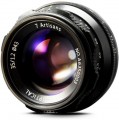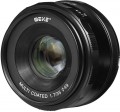System
The system indicates which brand of cameras this lens is designed for. Manufacturers of photographic equipment often use original mounting systems in their cameras that are not always compatible with each other; therefore, for normal use, the lens must be originally designed for the corresponding system. At the same time, note that the actual compatibility will also depend on the mount (see "Bayonet (mount)"). At the same time, one system often includes several mounts (for example, Canon and Nikon); it happens vice versa — one mount can be used in several systems at once (for example,
Micro 4/3 is used by both Olympus and Panasonic). In general, the optimal selection order is as follows: first clarify the compatibility of the lens with the system, then with a specific mount.
Also note that third-party manufacturers (who do not produce cameras and deal only with lenses) often produce models designed for several different systems at once. Such compatibility can be achieved both through a set of adapters (included in the package or sold separately), and through the release of different modifications of the same lens, differing only in mounts. The features of each such model should be specified separately.
Mount
The type of mount used to connect the lens to the camera. The name comes from the English "bayonet", meaning "bayonet" and a bayonet-type connection. Bayonet mounts are used in the vast majority of modern digital cameras due to their reliability and ease of use.
Full compatibility of the lens with the camera is guaranteed only if the types of their mounts match. Some mounts are compatible with each other via adapters, but such a connection can limit the capabilities of the lens (for example, it will make it impossible to use autofocus) and is generally not considered optimal. It is worth considering that within the same system (see above) different mounts are often used, which are also incompatible with each other.
So, the manufacturer Canon has mounts
EF-M,
EF-S,
EF,
RF,
RF-S. Leica has
Leica M,
Leica SL,
Leica TL. Nikon has
Nikon 1,
Nikon F,
Nikon Z in its arsenal. Pentax optics are equipped with
Pentax 645,
Pentax K,
Pentax Q. Samsung uses
NX-M and
NX mounts. Sony models include
Sony A and
Sony E. In addition, there are other types of mounts on the market - both branded (
Fujifilm G,
Fujifilm X,
Hasselblad H,
Sigma SA) and universal (
Four Thirds (4/3),
Micro 4/3).
Note that there are lenses that are declared compatible with several mounts at once. This “omnivorousness” can be realized in different ways. For example, some models have a non-standard mount on the lens body, and compatibility with various mounts is ensured through the use of adapters; These adapters can be included in the delivery set or purchased separately. Another option is that the lens is available in several separate modifications, each for its own mount. These details should be clarified before purchasing.
Aperture value
Lens aperture is a characteristic that determines how much the lens attenuates the light flux passing through it. It depends on two main characteristics — the diameter of the active aperture of the lens and the focal length — and in the classical form is written as the ratio of the first to the second, while the diameter of the active aperture is taken as a unit: for example,
1 / 2.8. Often, when recording the characteristics of a lens, the unit is generally omitted, such a record looks, for example, like this:
f / 1.8 or
f/2.0. At the same time, the larger the number in the denominator, the smaller the aperture value:
f / 4.0 lenses will produce a darker image than
models with f / 1.4 aperture.
Zoom lenses usually have different aperture values for different focal lengths. In this case, the characteristics indicate two aperture values, for the minimum and maximum focal lengths, respectively, for example: f / 4.5-5.6
The larger the aperture of the lens, the shorter shutter speeds it allows you to use when shooting. This is especially important when shooting fast-moving subjects, shooting in low light, etc. And if necessary, the light stream transmitted by the lens can be weakened using a diaphragm (see below).
Another point that directly depends on this indicator is the depth o
...f field (the depth of space that is in focus when shooting). The higher the aperture, the smaller the depth of field, and vice versa. Therefore, shooting with artistic background blur (bokeh) requires high-aperture optics, and for a large depth of field, you have to cover the aperture.Viewing angles
This parameter determines the size of the area of the scene being shot that falls into the frame. The wider the viewing angles, the larger the area the lens can capture in one shot. They are directly related to the focal length of the lens (see "Focal length"), and also depend on the size of the specific matrix with which the optics are used: for the same lens, the smaller the matrix, the smaller the viewing angles, and vice versa. On our website, in the characteristics of optics, viewing angles are usually indicated when used with the matrix for which the lens was originally designed (for more details, see "Matrix Size").
Minimum focus distance
Minimum focus distance (m) - the smallest distance from which you can focus on an object and take a photo. Usually it ranges from 20 cm for wide-angle lenses to several metres for telephoto. In the macro mode of the camera or with the help of macro lenses, this distance can be less than 1 centimeter.
Maximum zoom
The degree of magnification of the object being shot when using a
lens for macro shooting (that is, shooting small objects at the maximum possible approximation, when the distance to the subject is measured in millimetres). The degree of magnification in this case means the ratio of the size of the image of the object obtained on the matrix of the camera to the actual size of the object being shot. For example, with an object size of 15 mm and a magnification factor of 0.3, the image of this object on the matrix will have a size of 15x0.3=4.5 mm. With the same matrix size, the larger the magnification factor, the larger the image size of the object on the matrix, the more pixels fall on this object, respectively, the clearer the resulting image, the more details it can convey and the better the lens is suitable for macro photography. It is believed that in order to obtain macro shots of relatively acceptable quality, the magnification factor should be at least 0.25 – 0.3.
Number of diaphragm blades
The number of blades provided in the design of the diaphragm (for details, see "Minimum aperture"). In fact, this parameter is important when shooting scenes with pronounced bokeh (blurred background) and a small depth of field: the more petals the aperture has, the smoother the glare from out-of-focus objects will turn out, while with a small number of petals they can look like polygons. The number of aperture blades has almost no effect on other shooting parameters. Modern lenses have an average of 7-9 petals; the smoothing provided by them in most cases is considered quite sufficient.
Filter diameter
Thread diameter for installation on the filter lens. Light filters are devices for changing the parameters of the light flux entering the lens. They can be used for highlighting individual colours, coloring the entire image in one colour, darkening the image, correcting colour temperature and light balance, shooting in the infrared range, etc. Also, a light filter can play the role of protection against pollution. For successful installation on the lens, the diameter of the filter must match the diameter of the filter specified for this model of optics.

